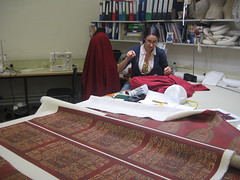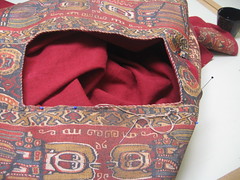By Stuart Frost
If you’ve been following this blog for a long period of time you’ll know that I’ve written about the tunic from Egypt before (Museum no. 291-1891). In fact I first wrote about the work Elizabeth-Anne Haldane, Senior Textile Conservator, was doing on the tunic back in June 2007 and provided another update in November 2008. Those entries are archived if you haven’t read seen them before. The gap between those blog entries, and this one, give some sense of how long the process of preparing an object for display can be. The team involved, however, have been working on other projects and objects at the same time. The previous blog entries also highlight how much new information can be gained about an object through intensive interdisciplinary research.
In developing the displays and the activities that go alongside them we’ve endeavoured to adhere to a number of key principles. One of those was that we wanted to offer visitors opportunities to actively engage with the displays and to experience some things directly for themselves. Whilst there will be plenty of materials for people to touch throughout the new galleries, we’ve worked hard to ensure that these activities are ‘minds on’ as well as ‘hands on’. The activities have to help enhance peoples’ understanding of the objects in a meaningful and enjoyable way.
We decided at an early stage that we’d like to include accurate replicas of clothing for visitors to try on in the Discovery Area spaces. The Egyptian tunic was an obvious candidate for various reasons, some of which were simply practical. For example the tunic is a garment that can easily be slipped over visitors’ existing clothing. The tunic was made between 642-800 and unlike later medieval clothing, often adorned with luxurious velvet and extravagant fur linings, the tunic was made from materials that we could replicate authentically without the cost soaring beyond the available budget.
After a number of meetings and discussions the project began to take shape. As you can see from the pictures that illustrate this blog entry work on the facsimile tunic has made significant progress. Keira Miller has been working away in the Textiles Conservation studio at the V&A, making templates, cutting fabric and stitching the seams together. Click on the pictures more information about what is shown. The production of the tunic, and a number of spares, is almost complete. It has been wonderful to see the results of Keira’s and Elizabeth-Anne’s work taking shape.
The replica of the Egyptian tunic adheres to another of the principles that underpins our approach to gallery based interpretation. It is informed by the results of new research stimulated by the redevelopment of the galleries. We wanted some of the interactives and activities in the gallery to reflect new research but to present in away that was meaningfully and engaging for visitors of all ages. I think the tunic will achieve this in a very effective way. It is one thing to see a tunic hanging on a mount behind glass, quite another to pull it over one’s head and to experience moving around in a garment. Experience from other projects at the V&A proves that adults enjoy trying on clothing as much as younger visitors. Whilst anyone will be able to try the tunic on, the replica will reflect the dimensions of the original and will look at its best on an adult.
We were keen that the replica should be as authentic as possible and the results of the research into the object have helped us achieve that objective. The cost of commissioning real tapestry decoration to be stitched to the tunic was beyond the available budget. However Elizabeth-Anne sourced a digitally printed alternative of high quality that was produced and supplied by Zardi and Zardi. You can see the printed fabric in both pictures.
When the replica tunic is finished I’ll post some more pictures here and hopefully a short film showing what the tunic looks like when it is worn. If you’d like to know more about the conservation work and the results of the research into the original tunic an article by Elizabeth-Anne will published in November 2009 in the V&A’s Conservation Journal. As ever if you have any questions or comments please post them below and I’d do my best to respond promptly and helpfully.
To see a film about the conservation of the tunic follow the link given below:
http://www.vimeo.com/6175424